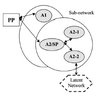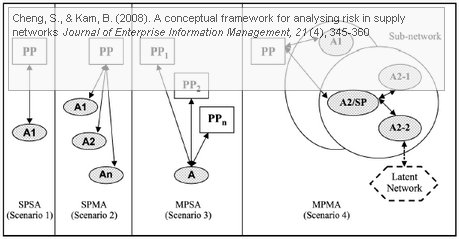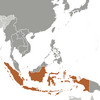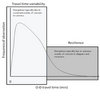 Sometimes the most interesting articles are found outside the mainstream journals of ones field, and so it is with Seu Keow Cheng and Bon Hooi Kam (2008) A conceptual framework for analyzing risk in supply networks, found in the Journal of Enterprise Information Management, a very unlikely journal for finding a paper on supply chain risk. It is not often that I see a paper focusing on the network relationships risks rather than the network risks, let alone applying the principal-agent theory so elegantly.
Sometimes the most interesting articles are found outside the mainstream journals of ones field, and so it is with Seu Keow Cheng and Bon Hooi Kam (2008) A conceptual framework for analyzing risk in supply networks, found in the Journal of Enterprise Information Management, a very unlikely journal for finding a paper on supply chain risk. It is not often that I see a paper focusing on the network relationships risks rather than the network risks, let alone applying the principal-agent theory so elegantly.
Principal-Agent Structures
The paper analyzes risk for four basic principal-agent scenarios:
- SPSA (single principal, single agent)
- SPMA (single principal, multiple agent)
- MPSA (multiple principal, single agent)
- MPMA (multiple principal, multiple agent)
For each scenario, possible risk factors, risk dynamics and risk impacts in the network are explored.

Risk factors
Following Jüttner et al. (2003) and Peck (2005), and building on the tenets of principal-agent theory, the authors divide the risk factor into four groups:
- Environmental risk
- Infrastructure risk
- Service delivery risk
- Organizational and relationship risk
This deviates from the classic supply-demand-operations-environment risk scheme applied by most researchers within supply chain risk, but it makes sense when looking at it from a principal-agent perspective and how relationships are formed and, in worst case, destroyed.
Risk dynamics
The risk dynamics are an interesting concept. Somewhat similar to the risk drivers of Jüttner et al. (2003), while at the same time unique to networks:
- Preconditions
- a network attribute necessary for a risk event to manifest itself
- Events
- whose likelihood depend on the preconditions
- Footprints
- the immediate impact zone of links and nodes that are affected
- Propagation
- the pathway of impact through the network
- Backlash
- upstream effects of downstream impacts
The impact of the risk event on the elements (links and nodes) of the network within the footprint (the immediate affected area) will depend on the abilities of the elements to resist and recover from the event.
Risk impacts
Because a supply network is considered to be hierarchically structured, the risk impacts are felt at several levels, either the entire network, or only parts of it:
- Level 1
- affecting the entire network
- Level 2
- affecting a sub-network, can propagate to the entire network unless contained
- Level 3
- affecting one individual node or link, can propagate into a sub-network unless contained
Obviously, the nature of network relationships within and between these levels defines how risk impacts propagate and, in turn, how effective any recovery action will be.
Comparative analysis
The paper concludes with a comparative analysis (or matrix) of the risk factors, risk dynamics and risk imapcts vis-a-vis the four principal-agent structures, SPSA, SPMA, MPSA and MPMA, showing that
Risk factors and the dynamics of risk depend not only on on the typology of networks, but also on the relationship inherent in the network through agreements and incentives. Even in the simplest of cases, the dynamics of risk is not simply about supply disruption. Exogenous risk can arise from latent networks and hidden perceptions and assessments that the principals and agents engage in during supply process negotiations. In complex networks, effective management requires understanding of the backlash from risk impacts, particularly those affecting the principal, and risk recovery options. […] Assessing and balancing these compromises, in addition to meeting the needs for supply delivery, are key facets of a resilient and successful network.
Conclusion
The strength of the paper lies in the side-by-side comparisons of risks in the different principal-agent structures, showing how inter-dependencies and inter-relationships affect how risks affect individual parts of the network or even the whole network. This “tool” can be use in assessing existing supply networks just as much as for setting up new supply networks
Reference
Cheng, S., & Kam, B. (2008). A conceptual framework for analysing risk in supply networks Journal of Enterprise Information Management, 21 (4), 345-360 DOI: 10.1108/17410390810888642
Author links
- researchgate.net: Bon Hooi Kam
- researchgate.net: Seu Keow Cheng
Related
- husdal.com: Another tale of principals and agents
- husdal.com: A Future Research Agenda for Supply Chain Risk Management












